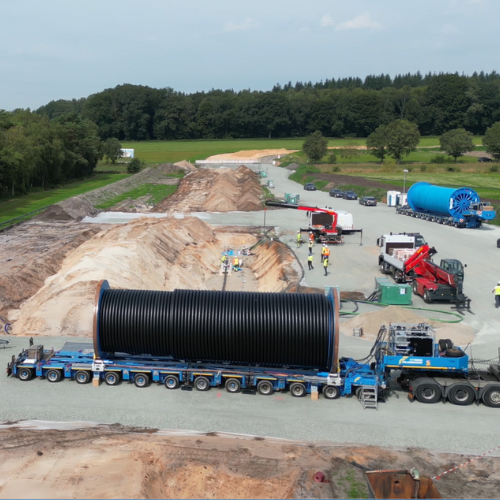Prysmian is playing a key role in developing three energy cable projects that will transport the clean energy generated by wind power of the northern shores of Germany to the industry intensive south of the country. The three innovative projects, SuedLink, SuedOstLink and A-Nord, will support Germany’s energy transition and will contribute to achieving decarbonization goals in Europe.
At the heart of the European Energy Transition: Prysmian starts the installation of SuedLink project in Germany

Prysmian has kicked-off the first HVDC cable installation for SuedLink this August. The project was awarded to Prysmian by German transmission grid operators Transnet BW GmbH and TenneT TSO GmbH with the mission to design, manufacture, supply, lay, joint, test and commission a 580 km cable system that will deliver a ±525 kV High Voltage Direct Current with the capacity to transmit 2GW of electrical power. The route, from Wilster in Schleswig-Holstein, to the north-west of Hamburg, will run the length of Germany to the southern connection point at Bergrheinfeld, close to Schweinfurt in Bavaria. The cables have been produced in Prysmian's centers of excellence for underground cable manufacturing in Europe. It is composed of large copper conductors with extruded XLPE insulation technology at the highest voltage level.
Prysmian is the global leader in high voltage submarine and underground cables, essential both for offshore wind power generation and for interconnections between different systems, countries and regions for the development of larger, smarter and more sustainable power grids.

HVDC underground cables present several benefits to energy final users and communities living where they are installed because they help preserve the landscapes, limiting visual obstructions and they are less likely to be impacted by increasingly common extreme weather since they are protected. Cable systems designed at a higher voltage level and with large conductor cross-sections provide optimal technical solutions for long distance and high-power transmission with minimized land use. 525 kV allows a reduced quantity of cable to transmit the same power requiring less space, less trenches and less civil works to install the system.

After the landscape has recovered, following the installation of the underground cable system, the new transmission line will be invisible in any open countryside. In addition, there’s nearly no limitation to agriculture and farming on top of the trench once the installation is completed. The long-term social benefits of these type of interconnections outweigh the initial investment costs and result in minimal cost implications to the end consumer. HV underground cables secure long-term electricity supply and represent the future of sustainable electricity transmission in Europe.
The second project to be installed is the SuedOstLink, with the installation campaign planned to start in the coming weeks.
SuedLink project highlights

Type of cable

Prysmian cable route

Start of cable installation





